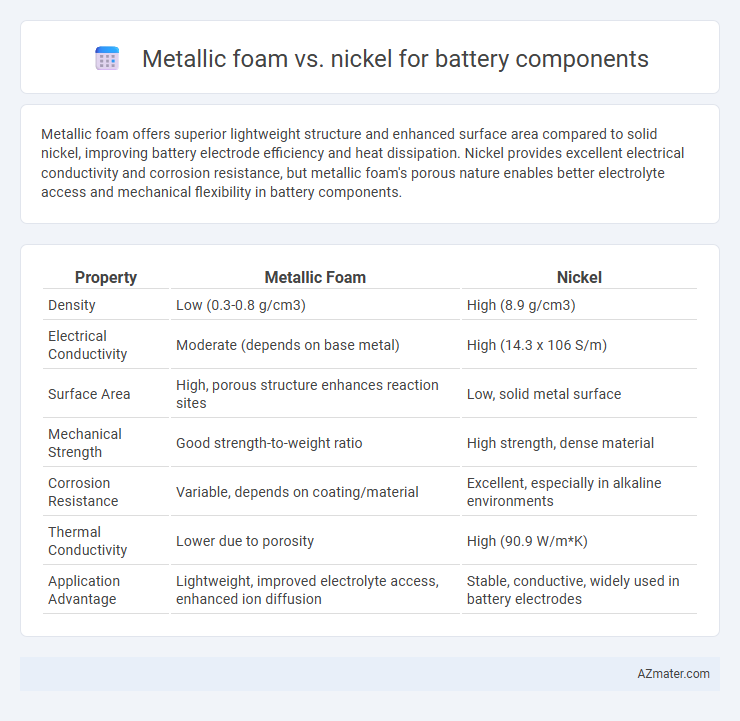Metallic foam offers superior lightweight structure and enhanced surface area compared to solid nickel, improving battery electrode efficiency and heat dissipation. Nickel provides excellent electrical conductivity and corrosion resistance, but metallic foam's porous nature enables better electrolyte access and mechanical flexibility in battery components.
Table of Comparison
| Property | Metallic Foam | Nickel |
|---|---|---|
| Density | Low (0.3-0.8 g/cm3) | High (8.9 g/cm3) |
| Electrical Conductivity | Moderate (depends on base metal) | High (14.3 x 106 S/m) |
| Surface Area | High, porous structure enhances reaction sites | Low, solid metal surface |
| Mechanical Strength | Good strength-to-weight ratio | High strength, dense material |
| Corrosion Resistance | Variable, depends on coating/material | Excellent, especially in alkaline environments |
| Thermal Conductivity | Lower due to porosity | High (90.9 W/m*K) |
| Application Advantage | Lightweight, improved electrolyte access, enhanced ion diffusion | Stable, conductive, widely used in battery electrodes |
Introduction to Battery Component Materials
Metallic foam and nickel are critical materials in battery components due to their unique structural and conductive properties. Metallic foam offers a high surface area, lightweight structure, and excellent electrical conductivity, enhancing electrode performance and energy density. Nickel, widely used in battery electrodes, provides superior corrosion resistance, mechanical strength, and efficient charge transfer essential for long-lasting battery systems.
Overview of Metallic Foam in Batteries
Metallic foam, characterized by its high porosity and large surface area, offers superior electrical conductivity and efficient electrolyte diffusion, making it an ideal material for battery electrodes. Its lightweight structure enhances energy density and mechanical stability, which are critical for high-performance lithium-ion and metal-air batteries. Compared to solid nickel components, metallic foam improves charge-discharge rates and cycle life by facilitating better ion transport and reducing internal resistance.
Properties of Nickel in Battery Applications
Nickel exhibits high electrical conductivity and excellent corrosion resistance, making it a preferred material for battery electrodes and current collectors. Its ability to maintain structural integrity under repeated charge-discharge cycles enhances battery longevity and performance. Nickel's catalytic properties also improve electrochemical reactions, contributing to higher energy density and efficiency in battery applications.
Conductivity Comparison: Metallic Foam vs Nickel
Metallic foam exhibits superior electrical conductivity compared to solid nickel due to its porous structure, which enhances electron transport while maintaining a lightweight profile. Nickel, though highly conductive and corrosion-resistant, has a denser structure that can limit charge transfer efficiency in battery components. The enhanced surface area of metallic foam provides improved current distribution, making it more effective for high-performance battery electrodes.
Structural Differences and Their Impact
Metallic foam features a porous, lightweight structure with high surface area, enhancing ion transport and reducing battery weight compared to dense, solid nickel. The cellular architecture of metallic foam improves mechanical flexibility and stress distribution, minimizing structural degradation during charge cycles. In contrast, solid nickel offers higher electrical conductivity but lacks the structural benefits, often resulting in increased weight and reduced durability under mechanical strain.
Energy Density and Performance Analysis
Metallic foam exhibits superior energy density compared to nickel when used in battery components, owing to its high porosity and lightweight structure that enhances electrode surface area and ion transport. Nickel, while providing excellent electrical conductivity and corrosion resistance, often falls short in delivering comparable energy storage capacity and rate performance. Performance analysis reveals metallic foam-based electrodes offer improved charge-discharge cycles and higher power density, making them more efficient for advanced battery applications.
Cost Implications: Metallic Foam vs Nickel
Metallic foam offers significant cost advantages over pure nickel in battery components due to its lower material consumption and lightweight structure, reducing overall production expenses. The porous nature of metallic foam minimizes raw material costs while maintaining efficient electrical conductivity and mechanical stability. Nickel's higher price and density contribute to increased manufacturing costs and heavier battery weights, impacting final product affordability and performance.
Durability and Lifespan in Battery Components
Metallic foam offers superior durability in battery components due to its high porosity, which enhances electrolyte flow and reduces mechanical stress during charge cycles, extending lifespan. Nickel, while highly conductive and corrosion-resistant, may suffer from surface degradation over prolonged use, impacting overall battery longevity. The innovative structure of metallic foam significantly improves cycle stability and structural integrity compared to traditional nickel-based components.
Environmental and Recycling Considerations
Metallic foam offers superior recyclability compared to nickel, as its porous structure reduces material usage and lowers the environmental footprint during production. Nickel extraction and refining are energy-intensive, contributing to significant greenhouse gas emissions and environmental degradation. Incorporating metallic foam in battery components supports circular economy principles by enabling easier material recovery and reducing toxic waste associated with nickel processing.
Future Trends in Battery Material Innovation
Metallic foam offers a unique combination of lightweight structure and high surface area, enhancing electrode conductivity and electrolyte interaction in battery components. Nickel remains a critical material due to its excellent electrochemical stability and energy density, but future trends indicate a shift towards hybrid materials incorporating metallic foam to improve performance and reduce weight. Innovations focus on optimizing porous metallic foams with nickel alloys to enhance durability, charge rates, and overall battery lifespan in next-generation energy storage solutions.

Infographic: Metallic foam vs Nickel for Battery component
 azmater.com
azmater.com